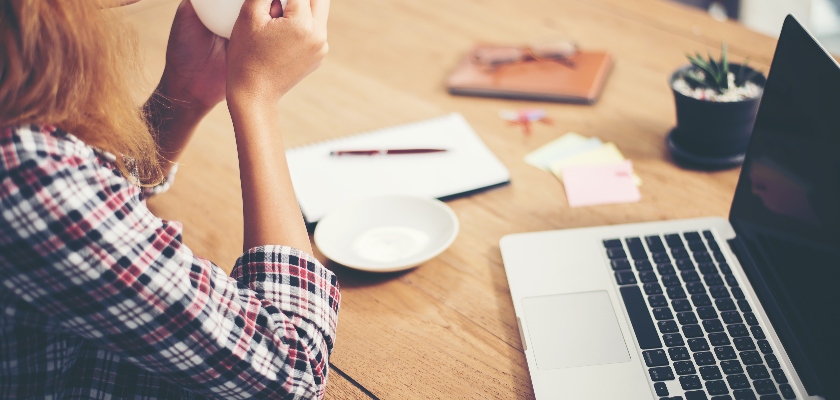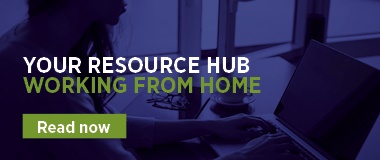THE POST-COVID-19 WORKPLACE: WILL IT SUIT YOUR WORKING STYLE?
Jane McNeill Director, Hays Australia

Continuing physical distancing measures will see your former open-plan office layout replaced with a new seating plan, separated desks and dividers. It will likely lead to you returning to your workplace on a roster system with staggered start and finish times. There will also be fewer in-person meetings and informal brainstorming sessions around a colleague’s computer.
In short, the workplace will be redesigned to keep people further apart than most of us have ever experienced before in our working lives.
Of course, while you will encounter far more in-person interactions with your colleagues compared to your work from home experience, you should expect to wave goodbye to pre-pandemic levels of contact.
So, if you are the type of person who thrives and performs at your best when interacting in-person with your colleagues, such as dropping by their desk to bounce ideas around, and draws your energy from face-to-face conversations at work, you should take the time now to adapt and find alternative measures to motivate your best efforts in the post-COVID-19 workplace.
To prepare, here’s what you need to consider.
You’ll have less in-person informal and social conversations
Firstly, you should expect your office space to look very different. To comply with continued physical distancing measures, your employer will have reconfigured seating plans and moved desks apart to separate people. You may even find yourself further separated from colleagues by partitions.
Hot-desking, where several employees use a single work station at different times, will also go by the wayside as employers assign employees their own equipment and look to reduce the number of shared touchpoints people come into contact with on a daily basis.
In addition, you’ll no longer be able to sit and chat with colleagues in a break-out area or a communal kitchen.
By keeping staff physically distant, there will be fewer opportunities for in-person conversations. You can no longer simply look up from your monitor and ask a quick question, for example, or roll your chair over to your colleague’s desk to talk through an idea. Neither can you crowd into a meeting room for an in-person consultation with all your teammates.
You’ll see colleagues less
Organisations will transition their workforce back into the office in stages to reduce density in the workplace. A roster system is the most likely strategy to begin with, which will see you continuing to work from home on certain days and coming into the office on others. This means you’ll only initially see those colleagues who are rostered to work in the office on the same day or days as you.
Employers may also adopt staggered start and finish times to further reduce the number of employees gathering at the lift at the beginning and end of each day.
In addition, many people are expected to ask to continue to work from home after the pandemic, even once restrictions lift and employees can return fulltime to the office. With widespread understanding that employees can work successfully from home, hybrid teams will become common.
As a result, the notion of having all your colleagues in the one co-located workplace all the time is a thing of the past. Instead, you’ll need to become comfortable operating in a hybrid team where face-to-face interactions with all your team members occurs far less frequently.
If you thrive on face-to-face interaction, find alternatives
Together, these changes result in a less interactive environment. Chances are you’ll either relish or loath this change. After all, all workplaces consist of people with a mixture of working styles. Some people shine in a collaborative, team-based environment where they can seek out in-person social stimulation, think out loud with others and brainstorm together at their desk.
In contrast, the introverts in your workplace thrive when working on individual tasks, value privacy, like to make their own decisions rather than consult a group, and come up with their best ideas after contemplating a problem on their own.
The latter group will welcome these workplace changes, while the former will miss the hustle and bustle of a full office, the opportunity to drop by their colleague’s desk to bounce ideas around and the chance to work closely with others in a group setting. So, if you have previously thrived in a social, connected and collaborative environment, you will need to find new ways to keep your motivation, energy and output high.
Six ways to adapt if your working style doesn’t suit post-COVID-19 workplace changes
1. Create virtual informal social conversations. Begin by working out how you can continue to use virtual alternatives to build rapport and interactions with your colleagues. Over the last few months, we have all used communication platforms to hold regular virtual meetings and make video calls with our colleagues. However, the days of relying on such tools are far from over – the need to comply with physical distancing measures means that teams will still use these tools for a significant portion of their face-to-face interactions, especially in hybrid teams where some colleagues continue to work remotely.
Given that we will still rely on such tools, why not make the most of them by dedicating time in each meeting for small talk? For example, you could invite people to remain for ten minutes after your weekly team meeting or join ten minutes early for a casual chat. You may need to initiate the initial conversation, but you’ll likely find your colleagues will soon come to look forward to this opportunity to talk casually with their colleagues. This will give you a chance to recharge your energy through social conversations and interactions with others.
2. Create opportunities to think out loud. You could also ask to add into the weekly meeting agenda a dedicated time for brainstorming, where anyone can share a challenge they are facing or task they would like to talk through. If you are the type of person who generates their best ideas by talking them through with others, this will give you an opportunity to think out loud and discuss your thoughts.
3. Network online and pick up the phone. If you enjoy talking and socialising, and draw your energy from interactions with others, you could also up the amount of time you spend networking online and take every opportunity to pick up the phone and talk to colleagues. So long as you adhere to social distancing, you can still talk through an idea with colleagues who are working in the office too, but it’s important to be mindful that not everyone will want you regularly dropping by their desk.
4. Ask if you can be assigned additional days in the office. If you require the hum of activity in a busy office to do your best work, ask your employer if you can return permanently to the office. While your employer may need to restrict the number of employees who can work in the office initially, there may be someone in your team who would prefer to work exclusively from home. If that’s the case, ask if you could be assigned their allocated office-based days on the roster.
5. Upskill. It may also help you to use this time to upskill in independent working techniques. Learning how to self-motivate, trust your instincts and individually solve problems without needing to talk through ideas with others are skills that will benefit you long-term in your career.
There are many tools and platforms out there for you to choose from when it comes to upskilling remotely at this time, from podcasts to virtual webinars and reading top business books.
With fewer opportunities to chat casually at your colleagues’ desks or while sitting down over a quick cup of tea in the kitchen, you may also find that your productivity or quality of work improves as you have more time to spend on your individual output.
6. Look after your wellbeing. Finally, it’s important to look after your mental wellbeing. If you thrive when working closely with others in a group setting, you may find yourself battling feelings of loneliness, even when you are back in the office. After all, those partitions and separated desks are designed to keep people further apart than most of us have ever experienced before at work, so look out for suitable opportunities where you can interact with others – just ensure you adhere to the necessary physical distancing while doing so.
To sum up, if you are someone who naturally performs at your best when interacting in-person with others, these tips should help you find new ways to keep your motivation, energy and output high in today’s modified workplace.
Sure, you won’t be pulling your chair up to a colleague’s desk for a chat or to brainstorm, but you can find alternative measures to bring out your best and interact with others safely in the post-COVID-19 workplace.
AUTHOR
 Jane McNeill joined Hays in 1987 as a graduate trainee in their London head office after graduating with an MA (Hons) in Psychology from Edinburgh University. She began her career recruiting accountancy & finance professionals, before spending 11 years recruiting senior permanent professionals for London’s banking & finance sector. During this time she quickly progressed through management roles and in 1992 she was appointed Director after leading the London city business to a phenomenal post-recession recovery. Jane transferred to Perth, Western Australia, in 2001. Over the next decade she grew Hays’ business in that state from a team of 15 to nearly 250 staff. She also established and managed Hays’ banking & financial services business. She was appointed to the Hays Australia & New Zealand management board in 2007. Now based in Sydney, Jane oversees Hays’ operations in both NSW and WA. She is responsible for 400 staff located in two states that are separated by a five-hour flight and a three-hour time difference. At the same time, she retains her keen interest and passion in banking & financial services recruitment by adding national responsibility for Hays Banking and Hays Insurance to her remit.
Jane McNeill joined Hays in 1987 as a graduate trainee in their London head office after graduating with an MA (Hons) in Psychology from Edinburgh University. She began her career recruiting accountancy & finance professionals, before spending 11 years recruiting senior permanent professionals for London’s banking & finance sector. During this time she quickly progressed through management roles and in 1992 she was appointed Director after leading the London city business to a phenomenal post-recession recovery. Jane transferred to Perth, Western Australia, in 2001. Over the next decade she grew Hays’ business in that state from a team of 15 to nearly 250 staff. She also established and managed Hays’ banking & financial services business. She was appointed to the Hays Australia & New Zealand management board in 2007. Now based in Sydney, Jane oversees Hays’ operations in both NSW and WA. She is responsible for 400 staff located in two states that are separated by a five-hour flight and a three-hour time difference. At the same time, she retains her keen interest and passion in banking & financial services recruitment by adding national responsibility for Hays Banking and Hays Insurance to her remit.


